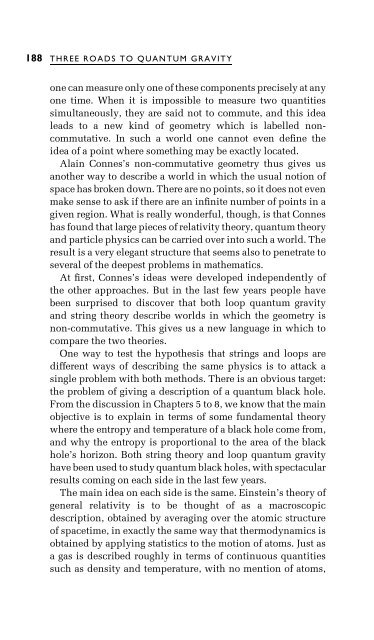Three Roads To Quantum Gravity
Three Roads To Quantum Gravity
Three Roads To Quantum Gravity
Create successful ePaper yourself
Turn your PDF publications into a flip-book with our unique Google optimized e-Paper software.
188 THREE ROADS TO QUANTUM GRAVITY<br />
one can measure only one of these components precisely at any<br />
one time. When it is impossible to measure two quantities<br />
simultaneously, they are said not to commute, and this idea<br />
leads to a new kind of geometry which is labelled noncommutative.<br />
In such a world one cannot even de®ne the<br />
idea of a point where something may be exactly located.<br />
Alain Connes's non-commutative geometry thus gives us<br />
another way to describe a world in which the usual notion of<br />
space has broken down. There are no points, so it does not even<br />
make sense to ask if there are an in®nite number of points in a<br />
given region. What is really wonderful, though, is that Connes<br />
has found that large pieces of relativity theory, quantum theory<br />
and particle physics can be carried over into such a world. The<br />
result is a very elegant structure that seems also to penetrate to<br />
several of the deepest problems in mathematics.<br />
At ®rst, Connes's ideas were developed independently of<br />
the other approaches. But in the last few years people have<br />
been surprised to discover that both loop quantum gravity<br />
and string theory describe worlds in which the geometry is<br />
non-commutative. This gives us a new language in which to<br />
compare the two theories.<br />
One way to test the hypothesis that strings and loops are<br />
different ways of describing the same physics is to attack a<br />
single problem with both methods. There is an obvious target:<br />
the problem of giving a description of a quantum black hole.<br />
From the discussion in Chapters 5 to 8, we know that the main<br />
objective is to explain in terms of some fundamental theory<br />
where the entropy and temperature of a black hole come from,<br />
and why the entropy is proportional to the area of the black<br />
hole's horizon. Both string theory and loop quantum gravity<br />
have been used to study quantum black holes, with spectacular<br />
results coming on each side in the last few years.<br />
The main idea on each side is the same. Einstein's theory of<br />
general relativity is to be thought of as a macroscopic<br />
description, obtained by averaging over the atomic structure<br />
of spacetime, in exactly the same way that thermodynamics is<br />
obtained by applying statistics to the motion of atoms. Just as<br />
a gas is described roughly in terms of continuous quantities<br />
such as density and temperature, with no mention of atoms,



![arXiv:1001.0993v1 [hep-ph] 6 Jan 2010](https://img.yumpu.com/51282177/1/190x245/arxiv10010993v1-hep-ph-6-jan-2010.jpg?quality=85)


![arXiv:1008.3907v2 [astro-ph.CO] 1 Nov 2011](https://img.yumpu.com/48909562/1/190x245/arxiv10083907v2-astro-phco-1-nov-2011.jpg?quality=85)








![arXiv:1002.4928v1 [gr-qc] 26 Feb 2010](https://img.yumpu.com/41209516/1/190x245/arxiv10024928v1-gr-qc-26-feb-2010.jpg?quality=85)
![arXiv:1206.2653v1 [astro-ph.CO] 12 Jun 2012](https://img.yumpu.com/39510078/1/190x245/arxiv12062653v1-astro-phco-12-jun-2012.jpg?quality=85)
